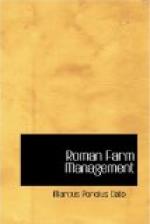“You will find,” said I, “many other wonderful secrets in Saserna, all equally foreign to agriculture, and so all to be left where they are. But it must be admitted that such digressions are found in many other authors. Does not the agricultural treatise of the great Cato himself fairly bristle with them, as for instance his instructions how to make must cake and cheese cake, and how to cure hams?”
“You forget,” said Agrius, “his most important precept: ’If you wish to drink freely and dine well in company, you should eat five leaves of raw cabbage steeped in vinegar, before sitting down to the table.’”
b. What agriculture is
III. “And so,” said Agrasius, “as we have agreed upon and eliminated from the discussion all those things which agriculture is not, it remains to discuss what it is. Is it an art, and, if so, what are its principles and its purposes?”
Stolo turned to Scrofa and said: “You are our senior in age, in reputation and in experience, you should speak.” And Scrofa, nothing loath, began as follows:
“In the first place, agriculture is not only an art but an art which is as useful as it is important. It is furthermore a science, which teaches how every kind of land should be planted and cultivated, and how to know what kind of land will produce the largest crops for the longest time.[57]”
The purposes of agriculture are profit and pleasure
IV. The elements with which this science deals are the same as those which Ennius says are the elements of the universe—water, earth, air and fire. Before sowing your seed it behooves you to study these elements because they are the origin of all growing things. So prepared, the farmer should direct his efforts to two ends: profit and pleasure,[58] one solid the other agreeable: but he should give the preference to the pursuit of profit.[59] And yet those who have regard for appearances in their farming, as for instance by planting their orchards and olive yards in orderly array, often add not only to the productiveness of the farm but as well to its saleability, and so doubly increase the value of their estate. For of two things of equal usefulness, who would not prefer to buy the better looking?
The farm which is healthiest is the most valuable, for there the profit is certain. On the other hand, on an unhealthy farm, however fertile it may be, misfortune dogs the steps of the farmer. For where the struggle is against Death, there not only is the profit uncertain, but one’s very existence is constantly at risk: and so agriculture becomes a gamble in which the farmer hazards both his life and his fortune. And yet this risk can be diminished by forethought, for, when health depends upon climate, we can do much to control nature and by diligence improve evil conditions. If the farm is unhealthy by reason of the plight of the land itself, or of the water supply, or is exposed to the miasma which




